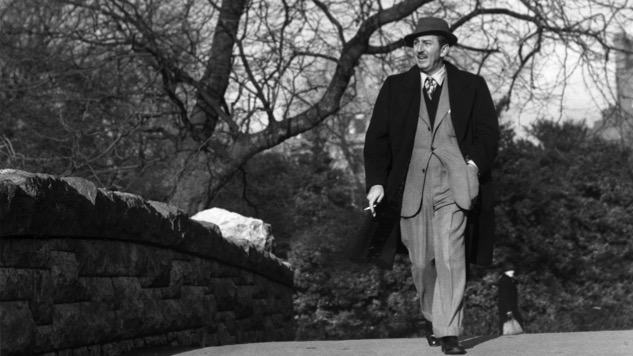By Jim Vorel |
March 16, 2021 |
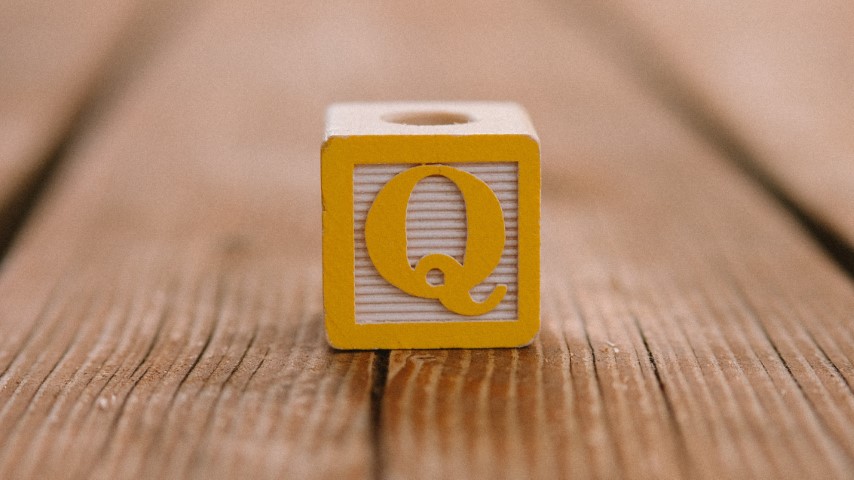
Ever since the election in November, we at Paste have been covertly plugged into the seedy online breeding grounds of the QAnon conspiracy theory— “free speech” right-wing internet bastions such as Gab and Parler, where violent fantasies are free to run wild as Anons (which is how they refer to themselves) prop each other up with hopes of violent revolution and the ever-delayed purge of their political enemies known as “The Storm.” I can assure you that spending countless hours in these internet hellholes is something I have no particular desire to be doing, but after becoming fascinated/obsessed by QAnon’s destructive influence and hate-mongering effect on American culture in the last three years, I saw it as something of a responsibility to keep an eye on the places where these terrifying discussions were happening. Lurking among them, I watched in real time as events such as the Jan. 6 insurrection at the Capitol made idle QAnon fantasizing into deadly reality.
In the months since the election, I’ve written a few sprawling deep dives into QAnon internet culture, in an attempt to explain how their beliefs operate and how they’re able to retain faith in obvious falsehoods, even after countless defeats. My first piece covered the entire period between Election Day and Inauguration Day, chronicling the unshakeable confidence of Anons who swore that Joe Biden would never be inaugurated as the 46th President of the United States on Jan. 20. The second piece likewise covered the Q influencer sphere during Biden’s first month as President, recording how Anons were attempting to rationalize their mounting defeats and the lies they’d been fed, such as the idea that Donald Trump would magically become the President once again on March 4, 2021.
After those two massive pieces, each filled with hundreds of (disturbing) images and screenshots, I feel like I’ve covered the basic ground of “what is QAnon?” pretty thoroughly at this point, and I’d like to permanently retire myself from the “collecting and synthesizing hundreds of screenshots” game. But try as I might, I can’t drag myself away from continuing to monitor QAnon chatter on Gab in particular, and I still believe that people may need to know what the cult of QAnon is obsessing about at any given time, especially if another event like Jan. 6 is a possibility.
Therefore, I’m launching this new monthly(ish) series, which I’m titling Dispatches From Q-Land. Each month or so, I’ll check in with the latest topics of frantic QAnon obsession, potential threats bubbling on echo chambers like Gab, and illustrate how Anons are perpetually attempting to rationalize their world and avoid having to confront reality.
Let’s get to it, then.
The Painful Cognitive Dissonance of Q Believers
If there’s one defining experience that almost all Anons are linked by, it’s that they almost all seem to be struggling with cognitive dissonance more than ever in this moment, whether they recognize it or not. In particular, there are a few specific topics that Anon communities find it very difficult to discuss these days, because their beliefs have a tendency to clash directly against their other beliefs, or the beliefs of other Anons. There are numerous subjects where Anons end up split right down the middle, with half believing one version of events and the other half believing the polar opposite. All of this is amplified by the fact that Q himself seems to have permanently disappeared, leaving the cult in flux, and without any voice of authority to establish doctrine. There still hasn’t been a single post from Q in 2021, and you can feel the directionlessness and lack of organization in Q communities as a result, because every influencer commands their own flock. Infighting abounds. In their current state, it’s hard to believe that Anons could agree to organize in pursuit of any specific task.
As far as specific topics of cognitive dissonance go, though, none is more pervasive than COVID-19 and the increasingly available coronavirus vaccine. From the beginning, QAnon has had a tough time deciding how to feel about COVID, with half believing that the virus doesn’t exist at all, and the other half claiming that COVID is a biological weapon developed by the Chinese to target Americans. This results in some Anons highlighting that “COVID is a hoax,” or “COVID is no worse than the cold,” while others dramatize it as a plague unleashed by the evil Deep State to target GOP seniors. The group’s struggles to arrive at consistent messaging on the virus itself, though, is nothing compared to their cognitive dissonance when it comes to the vaccine. This is one of the issues where you can truly feel the anxiety in the air, as the group’s contradictory beliefs tear it in two directions at once.
 A typical Anon statement on “China Virus.”
A typical Anon statement on “China Virus.”As you might expect, Anons are united against the vaccine in a broad, general way. They paint it is as “rushed” to completion and dangerous, despite the fact that the “rush” happened during Donald Trump’s presidency, and despite the fact that Trump has always demanded credit for Operation Warp Speed’s role in speeding development of the vaccine. Some claim that the vaccine is literal poison, and that those who receive it will be dead in minutes, hours or days from its “DNA-altering” effects. Others believe it’s part of some kind of dystopian, New World Order-style microchipping program, complete with “the mark of the beast,” etc, which plays in nicely to the apocalyptic Christian mysticism that runs hand in hand with QAnon. Whether it’s from a rationale of personal freedom (“you can’t tell me what to put in my body,” etc), religious fundamentalism or conspiracy theories about being poisoned to death by the Deep State, it was pretty easy from the start for the average Anon to be anti-vaccine. And given that Trump had been largely silent about actively promoting the vaccine, Anons took that as tacit endorsement of their beliefs.
That has all changed in recent weeks, and it’s sent Anons into a tizzy. First, Trump unequivocally endorsed the vaccine during his speech at the Conservative Political Action Conference (CPAC), in his first major public appearance since Biden’s inauguration. For the first time, the former President told his own supporters that they should get vaccinated, saying this: “Everybody, go get your shot.” That line comes from the middle of a rambling passage in which Trump is demanding that he and his administration receive credit for the successful vaccine rollout, in which he also said the the following: “Never forget that we did it. Never let them take the credit because they don’t deserve the credit. They just followed, they’re following our plan … Joe Biden is only implementing the plan that we put in place. Never let them forget. This was us. We did this. And the distribution is moving along, according to our plan.”
EDIT: Tuesday night, Trump was asked again in a Fox News interview if he would recommend his supporters should receive the vaccine, and he said the following: “I would recommend it and I would recommend it to a lot of people that don’t want to get it and a lot of those people voted for me, frankly. But again, we have our freedoms and we have to live by them and I agree with that also. But it is a great vaccine. It is a safe vaccine and it is something that works.”
Only a day later, the following news broke: Both Donald and Melania Trump received the vaccine themselves in January at the White House. And last week, Trump put out yet another public statement, phrased like he was composing a Tweet on the toilet, demanding credit for the vaccine once again. As hard as it may be to believe, the following is an actual press statement from an actual, former President of the United States. Frightening, I know.
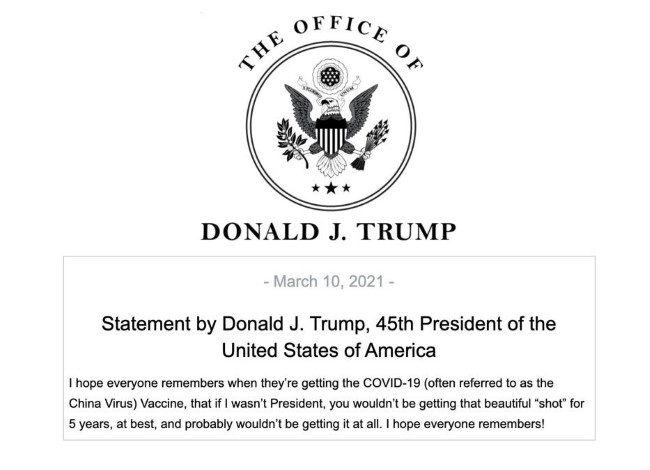
Unsurprisingly, this has made life damn near excruciating for Anons who believe that the vaccine is a Deep State plot to inject literal poison into our veins. Why would Donald Trump, the figurehead deity of all QAnon belief, receive a deadly vaccine? Why would he tell millions of his supporters that they should receive a deadly vaccine? Why would he take time to release multiple statements wanting credit for a deadly vaccine or say that Joe Biden’s administration was “only implementing the plan that we put in place” when he’s talking about distributing a deadly vaccine? Who would want credit for a vaccine that kills people?
This leaves only two, equally undesirable conclusions for Anons to draw:
1. Donald Trump is telling millions of his supporters to receive a deadly vaccine, and has been a Deep State pawn all along. Millions of MAGA people will die from poisoned vaccines.
2. The vaccine isn’t actually dangerous, and Trump merely wants credit for a popular thing. Which means that Q influencers have been lying about the vaccine for months.
Suffice to say, Anons really don’t care for either of those options, so they’re forced to confabulate other scenarios in which their delusion can be allowed to persist. Some might say, for instance, that “Trump didn’t receive the real vaccine,” ignoring the fact that millions of MAGA people still would be receiving the real, apparently deadly, vaccine. Some Anons straight-up deny that Trump ever said “everybody, go get your shot” at all, despite there being countless transcripts and video of him saying exactly that, along with the fact that he continues to take credit for the vaccine in general. Others come up with scenarios where the deadly vaccines would exclusively target Anons and MAGA people, to explain why everyone else isn’t dying after getting their shots.
 AKA, “the vaccine is only dangerous to those who choose not to receive it!” Brilliant.
AKA, “the vaccine is only dangerous to those who choose not to receive it!” Brilliant.In fact, most Anons seem determined to create a universe in which the vaccine is dangerous, while simultaneously avoiding holding Donald Trump responsible for promoting and demanding credit for that same dangerous vaccine. In their reality, Donald Trump is literally telling millions of Americans to kill themselves with poison, and they’re fine with that. Why are they fine with that? Well, in the words of many Anons, it’s okay because “Trump knows that his supporters think for themselves, and a lot of them will never take the vaccine even if he says we should.” Never mind the fact that some percentage of MAGA voters will no doubt listen to Trump and get vaccinated, receiving shots of what Anons believe is poison. The average Anon can’t be bothered to care about those people, even when the people in question are their own allies, friends and family. Which is to say: Even if Anons were RIGHT, and the vaccine was poison, many wouldn’t care if Trump told their friends to receive it and those people subsequently died. Even then, many Anons wouldn’t have a problem with Trump. That’s how rooted they are in their beliefs—even with the cognitive dissonance killing them inside, they can’t break free from it.
Granted, in incredibly rare scenarios, you do come across the occasional Anon who is disgusted with Trump for encouraging the vaccine.
 “I put my life on the line for you and got nothing for return” is the QAnon version of “I ___ ___ ___ and all I got was this lousy T-shirt.”
“I put my life on the line for you and got nothing for return” is the QAnon version of “I ___ ___ ___ and all I got was this lousy T-shirt.”This same sort of cognitive dissonance applies to many other topics in the QAnon orbit as well. One notable example? The remaining National Guard troops stationed in Washington D.C. According to some QAnon influencers, the presence of the military in D.C. is a clear indication of Joe Biden’s tyrannical, anti-constitutional crusade to oppress Americans and rob us of our various freedoms. They show images of the fencing, and the soldiers, and draw easy comparisons to various tin pot dictators.
Of course, other Q influencers are still arguing that the “military is in control,” or that “Patriots are in control,” and that the military in D.C. is there under Donald Trump’s orders to confine Joe Biden and Congressional Democrats in what is apparently an entire prison city. In this scenario, the military is just waiting for the always just-around-the-corner orders to perform a bloody coup and topple the Biden administration, so that Trump can return to the White House. Once again, we’ve reached a scenario where Anons want to believe two mutually opposed things at the same time—that Joe Biden is abusing his military power as a dictator, and that Joe Biden doesn’t have any military power because the soldiers all still answer to Donald Trump. Again, Anons struggle mightily to reconcile these two beliefs.
For the sake of experimentation, I’ve occasionally tried to challenge Anons on Gab about some of these sources of cognitive dissonance, such as Trump endorsing the vaccine, or calling the Jan. 6 insurrection the work of Antifa, despite the fact that the participants in that siege proudly declare their loyalty to Trump. Rarely is it effective, but you do have to shake your head at some of the backflips that Anons are able to turn in order to justify not having to adjust their opinions. Pointing out that one person has espoused two, mutually opposed viewpoints does not tend to faze them—I’ve legitimately been told by Anons that “it doesn’t matter” if their views are factually correct or incorrect, but merely that they’re participating in the crusade. Suffice to say, this is thematically extremely appropriate for QAnon, in a belief system that has long been opposed to the very concept of objective truth. Talking with Anons feels a bit like going before a judge in a court case, only to be told “It doesn’t matter if we correctly find you guilty or not guilty; what matters is that I feel good about the result.”
QAnon Potpourri: Quick Bites of Lunacy
Here are some more topics that have been catching the eyes and overactive imagination of Anons lately.
1. QAnon on Dr. Seuss, et al
Getting riled up about “censorship” (while also calling for public executions of their enemies and expecting no consequences for it) has always been a QAnon tenant, so you better believe they were ready to get on board with a wider GOP push toward calling any kind of criticism “Cancel Culture.” In particular, they zoned in on absurd, non-news stories like Dr. Seuss being “canceled,” cherry picking bits of non-information while employing a steadfast ignorance to include context or the full story. Suffice to say, Dr. Seuss Enterprises this month announced that it would no longer be publishing six titles by Theodor Geisel that have been criticized over the years for their depictions of Black and Asian people. Those books include such illustrious titles as McElligot’s Pool, On Beyond Zebra!, Scrambles Eggs Super! and other minor Dr. Seuss titles you’ve never heard of.
So naturally, QAnon claimed that The Cat in the Hat had been banned, because they’re incapable of operating without hyperbole and deceit. It led to a proliferation of memes like this, which Anons use to incense and radicalize internet users who can’t be bothered to read any kind of context.

There’s nothing more QAnon than managing to misspell “Suess” in the midst of your meme implying that the Deep State is coming to take away your Bible.
2. Gab’s Embarrassing Hacks
The post-election period and subsequent ban of Donald Trump from every major social media platform was a boon to hucksters running two-bit, alt-right social media alternatives cloaked in the garb of being “free speech” bastions, and both Parler and Gab, along with others such as Telegram, have had their own moments in the MAGA sun since then. Parler was of course shut down for a lengthy period after Amazon web hosting revoked its services, establishing another theme: These businesses tend to have horrendous technical savvy, both when it comes to running their sites and delivering on the anonymity and security they promise their conservative users. In other words, what a site like Gab promises is usually completely different from what a site like Gab delivers.
This was all illustrated rather beautifully when novice hackers managed to shut down Gab entirely last month, stealing the data of pretty much every user in the process. Gab CEO Andrew Torba, a lovely man fond of saying that other social media services are “serving Satan” and posting memes that say women shouldn’t be allowed to vote, responded by refusing to pay ransom demands for user data, and posted that the site had been secured. And then, a week later, the site was hacked for a second time, with the attackers mocking Torba by taking over his account and posting the following.

That’s a mosaic, literally made from Gab user data and photos. The incidents only served to highlight the total lack of preparation by the Gab team to protect their users, who claim to value privacy and data protection more than any other subset of American society. To date, Gab still hasn’t even taken the most basic steps imaginable, such as making users reset their passwords, to keep users safe. It’s a good illustration of a basic adage: Don’t forget that these sites and their users tend to be just as incompetent as they are ignorant.
3. QAnon Transitions Away from Dates
In my last QAnon deep dive, a month into the Biden presidency, I wrote about how Q influencers in particular seemed to increasingly be realizing the obvious: Giving believers specific dates to focus on is bad business when you’re trying to keep them on the hook (and bleeding money into your account) for as long as possible. As such, and despite a massive amount of reporting from the traditional news media (far too much, to be honest), this is part of why QAnon’s much-publicized March 4 date passed without incident. Some Anons did indeed expect Trump to suddenly become President again on that date, but many others had been sufficiently warned off in advance from expecting anything. You can expect this to become the new norm.
QAnon influencers are in the business of peddling hope, or “hopium” as they say. If someone suggests a date is important in advance, and that date is far enough away on the horizon, Q influencers will run with it, offering their support to stoke the spirits of Anons and keep them in a perpetual state of anticipation. As the date gets closer, however, the influencers will slowly start to raise questions about its veracity. This culminates in renouncing the importance of the date on the eve of the non-event (to avoid being called wrong), along with shaming and then gaslighting Anons who say they’re expecting events on specific dates. They’ve even coined a term to more efficiently insult each other here, calling this “datefagging.”
You can now follow this process on pretty much any proposed Q-date of significance. For example, after the failure of March 4, many Anons immediately pivoted to March 20, on the 167th anniversary of the Republican Party’s founding. This interview with your typical Anon is rife with March 20 promises. March 20 has also been promised as important by some notable Q influencers, including perhaps my favorite account on all of Gab right now, a fellow named WhipLash347. Take a look at this very typical post of WhipLash’s, and see if you can read to the end without your brain melting out of your ears.
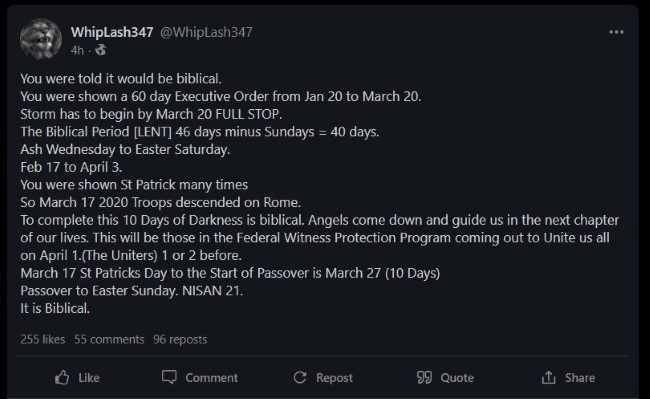
I wouldn’t blame you if you could no longer read the rest of this piece because you just chucked your computer monitor out the window, but in the off chance you’re still here, it gets even better. Not only is this schizophrenic, stream-of-consciousness style of prophecy exactly what WhipLash does on Gab every day to more than 24,000 followers, it came less than two weeks after his last failed prediction.
That’s right—WhipLash was a March 4 believer. In the days leading up to March 4, he stated that he was “100% certain” The Storm would finally occur on that date, and that him being incorrect about the issue was “statistically impossible.” When March 4 finally arrived, WhipLash responded by saying … nothing about his promise from a week earlier. Literally nothing. He just went on with business as usual, refusing to acknowledge he’d ever made the prediction at all.
Guess what his 24,000 followers said? If you stuck with “nothing,” you’d be about right, because even those Q influencers who do make constant failed predictions don’t tend to be held accountable for any of them. The vast majority of followers simply ignore failed predictions entirely, and focus on the next prediction. The few that do finally snap at repeated failures, meanwhile, are shouted down and viciously insulted by their own comrades, as in this exchange.
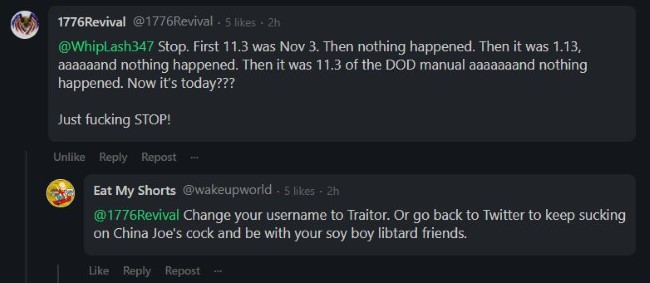
This is your reward for being an Anon for years, accepting everything you’re told, and then eventually having the gall to question someone who gave you a fake promise: Being called a “soy boy libtard” by the fellow Anon who’s supposed to be your loyal ally in the holy war against the Deep State. Instead of joining you in righteous indignation when you’re repeatedly lied to, your allies instead side with the person who continues to lie to them.
The smarter influencers, however, seem to realize that dates in general are more of a trap than they are a benefit, even if most believers will never hold them accountable for failed predictions. And as some of these disappointing dates have come and gone, I’ve begun to notice something: A lot of the influencers seem to be slowing down. Accounts that used to post a half dozen times a day or more now frequently go a few days between shorter posts. Increasingly, they look toward the future in a more vague and general way. It’s as if the Q movement is beginning to ossify into more of a long term, “power saving” mode, with the influencers pushing the attention of Anons away from obsessing over specific, unimportant events in the next week—which is their usual state of being—into a more long-term mindset that involves less active participation and more blind faith. In this version of QAnon, one simply sits at home and keeps the fires burning, stoking the personal conviction that everything will happen “on God’s time,” and that they don’t need to be personally involved. The influencers, meanwhile, can keep up the slow drip of hopium, selling books and merchandise, and asking for crowdfunding donations.
QAnon has so often been compared to a cult in the past, and the comparison is usually apt. But if anything, the group’s overtones are increasingly like an organized religion … except without the organization. I mean this in a sense of movement away from reactionary, revolutionary talk, of the “we need to go grab torches and pitchforks” sort, and more tired resignation in the direction of “we need to be patient and have faith.” As time goes by, Anon expectations deteriorate. They begin to reexamine their Q drop holy texts, and find ways to rationalize a long hiatus and justify the fact that they’ve run out of steam.
Perhaps some drift away from the group, or become “black pilled,” in the QAnon parlance. But many simply become less active, and organizing becomes harder and harder when any date that is put forth is shot down not by your enemies on the outside, but by your own allies. Eventually, you end up with a group militantly not doing anything, because when someone suggests a new prediction, another Anon replies with the following, blaming arrogant prognosticators for “THE DELAY.”
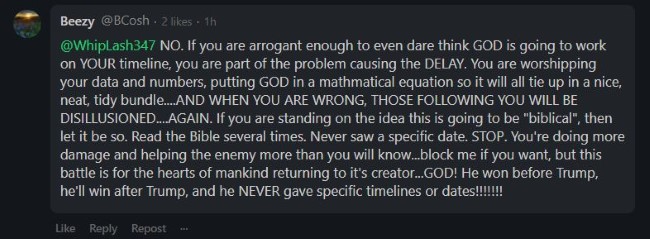
If that image doesn’t evoke the image of Anons as religious fundamentalists, patiently waiting for the apocalypse or end of days when they’ll receive salvation, I don’t know what would. Perhaps if we’re lucky, that’s exactly how the entirety of QAnon will end up, leaving the rest of the world well enough alone.
